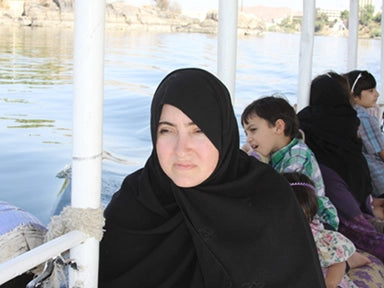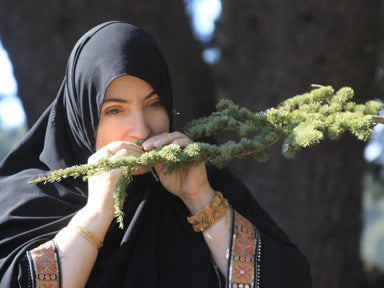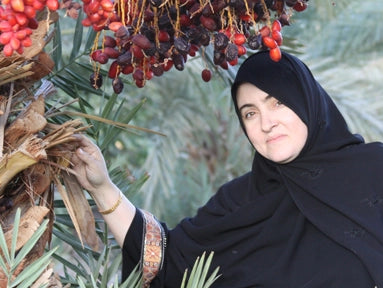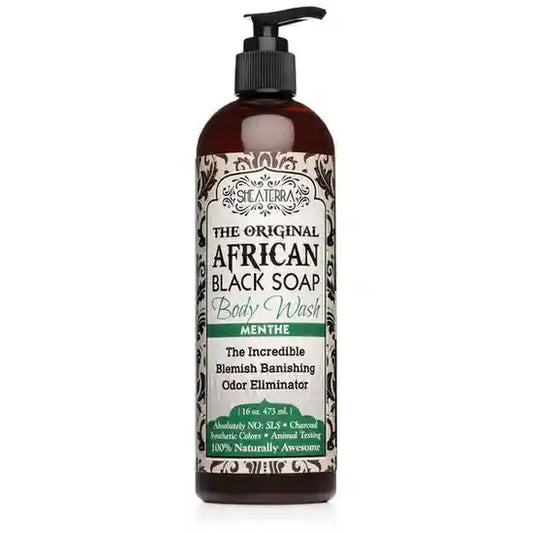I created the first Shea Terra products in 1999. We no longer have those products, but they formed the basis for how I formulated Shea Terra products. I think I was born with a miniature Shea Terra inside me. If anything, I probably came into this world with the seeds for Shea Terra. My earliest memories are my fondness for nature. I was a very curious child. I was very curious about plants and loved the aromas of nature. I was very sensitive to suffering and formed bonds with animals. I couldn’t imagine hurting an animal and pondered over how humans were destroying animal habitats. I had a fascination with cultures. I was particularly fond of the Chinese and Indian cultures. I learned everything that I could about distant places. I wanted to join the Peace Corp to help those in need. At the same time, I believed in empowering people. I felt it was more important to give someone the tools that they need to help themselves than to provide them with handouts. The more I look back at my life it seems that I was being prepared to create Shea Terra.
By no means were we privileged. I come from a long line of Appalachian mountain people. They ate squirrels and made moon shine. They had to find whatever means they could to survive. I was born in Atlanta but spent my young years in Florida. It was awesome. I got to experience living alongside gators and other wildlife. Later we moved to Maryland where my dad was from. He was born in Walter Reed hospital, parents of a WWII soldier and WWII nurse. This is where they decided I would go to school. We no longer traveled down south. My first school was a nice mixture of fair and dark-skinned students and faculty. It was an amazing school. As much as I disliked Maryland I later realized that growing up there was a blessing in disguise. Dark-skinned children and fair skin children played together without anyone pointing out to us that we were different. With time we had more and more international students. I loved getting to know about their cultures, and it was always a treat anytime I got to share their food. With time my mother became a single mom of three young children. Times were really tough. School clothes were hard to come by. I wouldn’t even ask for a pencil. I am not sure how I managed to get through school. Going without, I guess, helped me to understand how others in similar situations feel as well.
I was a different kind of kid. By no means was I typical. We moved around a lot and I was often by myself so I had to find ways of entertaining myself. I loved to draw and write stories and poems. I would try to dress up to look like people in different countries. I would watch Chinese movies on my small black and white tv. I loved sports and even made some state track records. I loved to play football, but I wasn’t a soccer kind of person. I made strange concoctions from things in the woods, and you would never want to leave me alone in your kitchen, or home for that matter. I also liked fashion and beauty. I once made a sauna in my friend’s bathroom and we ended up rubbing the paint of the walls. This is after I shaved her eyebrows. I loved going to the beach with my friend Min. She would carry me out into the water so the crabs didn’t bite my feet. She was brave. On the way back we would stop at 7-11 with my five dollars and get bags full of candy bars, Combos, Ho Hos…. Those were the days.
Brace yourself for this. I had it all figured out. When I was just a wee little girl I determined I was going to be a lawyer. My mom would ask me to share my career choice with adults. They would get a kick out of it. I said that I was going to be a lawyer, and they would ask me who was going to take care of my kids. I told them that my husband was going to stay home and take care of my kids. This was the 70’s. I was also determined to be the first woman president of the United States. I was going to change the world. I never considered there could be another woman president before me, and so far there hasn’t been anyhow, so I still could be the first.
Jane Goodall was my ultimate hero growing up. I was fascinated by her travels and ability to communicate with the animals. I watched as many documentaries on her work as was available. Today I can appreciate all that she did to educate the rest of the world about the importance of habitat conservation. In fact, she inspired a lovely biologist I work closely with. He now creates economic opportunities within communities by using indigenous ingredients to fund and encourage habitat conservation. Shea Terra uses several ingredients from his projects.
Namibia! What an amazing, beautiful place. It is mostly desert but it is brimming with life. Off the main road in Swakopmund we found an oasis. It took us about an hour to climb through the dunes in scorching heat to get to it. But it was all worth it. The dunes oasis was filled with hundreds of pelicans and my favorite- flamingos. It was breath taking. We then went to one of the highest dunes in the world Dune 7, where my kids climbed to the top and in a few seconds slid all the way to the bottom. While there we drank marula juice at the Etosha Wildlife Park. It was exciting to watch the animals come to the waterholes at night. I think that people in Africa are so blessed to have been able to be born where they are.
The memories of this trip still haunt me today. For years my father-in-law had brought my children pink salt rocks from the Himalayan Mountains where he lived. When I took my children there for a visit he thought it would be a good idea to take them to see the mine. At this point in our trip I was extremely ill, but I was up for the journey. Until…. There were two drivers with us, my father-in-law, my husband, eight of my children and myself in a van. We came to long bridge made from rope and boards. It was hanging over a deep ravine with a river below. I started yelling and screaming stating that there was no way that we are going to cross over that bridge. I let everyone know how stupid it was to endanger the children’s lives to let them see some salt. But no one would listen to me and so they began driving across the bridge anyhow. If we were just a few inches off we would fall into the ravine. At this point I closed my eyes and prayed. There was nothing else I could do to save us at this point. Thank God I am here today or there would be no Shea Terra. My children loved the mine. I was too sick to go in. I think back to how I almost lost my life yet never envisioned that Himalayan pink salt would actually become “a thing”. Good marketing!
For some reason people from other countries think that because I am a professional woman I don’t cook. I even have people from other countries who think that because I am American I CAN’T cook. And then there were my days in Saudi Arabia where the women told me that we American women go to McDonalds to feed our kids every day. Just writing this is making me want to bang my head on the wall. Yes- I do cook. Yes- I CAN cook. No- I don’t patronize McDonalds.
When I was growing up I was never allowed to cook. No- we didn’t have servants. My mom just didn’t want me in the kitchen. When I got married was the first time I ever got to cook. Since my husband is from Pakistan I had to learn the art of Pakistani cooking. It was an exciting culinary adventure. I make Indian curries, Moroccan curries, or even African style curries. I guess you can say that I am a curry cook. Sometimes I make chapatis. I have learned several African dishes as well, and sometimes make fufu. I cook the same way I create products. I hone in on my creativity. For me every dish and every product is an art just as much as it is a science. I have to be at one with my ingredients. I will study ingredients for years in order to understand how they work and what their growing subtleties are.
If someone saw my table that might think I am a slob. My nightstand is where I put all the samples I get from Africa. The samples sit there for many months, maybe a year before I retire them. I keep them there to look at them again and again before deciding whether I can incorporate them into our line. I recently retired several of the ingredients but before I did I had several all-natural hair color powders, bush mango butter, rare oils from the Cameroon, two rare clays, mussiro powder, and Ethiopian white honey. Right now I have our new body milks, three of our alcohol free toners, our new African pear oil, chebe powder from the Chad women, and a bag of very expensive jasmine tea pearls that I was gifted.
I am still discovering my favorite Shea Terra products. Unveiling hidden beauty gems is what keeps my candle burning. One product I don’t ever want to be without, Shea Terra’s core product, is Rose Hips Black Soap Face Wash. This wash keeps my skin looking so young and fresh. When I don’t use it wrinkles start to build up on my face. I really love the Kigelia Gob Tree Leaf Mask. It is a 2-n-1 facial cleanser and mask. It lightly exfoliates the skin while producing a light soapy cleansing. It is a leaf straight from nature but highly effective. Best yet it is environmentally safe and provides the women of Somalia money to purchase goods. I am also in love with our Rose Hips Lip Savior. This is an amazing lip gloss sort of conditioning lip balm made from wild African oils like African plum and desert date.
Of course, each Shea Terra formula has a unique story. I am more of an ethnobotanist than anything else. I study the use of plants by indigenous peoples. I am interested in finding out what plants are utilized by different communities, and how they are used. Once I understand the benefits of different plant materials I start thinking of ways to formulate them into products which Westerners (our key market) can understand. Every formula is built upon my commitment to generosity. When I formulated my first products, I decided that I would give as much of the active, costly ingredients as possible. I decided it was better to give people their money’s worth rather than try to squeeze as much profit out of my products as possible. My faith teaches me the rewards of kindness and charity. When people buy from Shea Terra I want to make them happy. I want to touch people’s lives. My rewards are the emails I get from our customers telling me how our products have transformed their lives.
There are several ways I source my ingredients. I have spent more than thirty years learning about beauty rituals from other countries. Some of this was from travels, but usually it was shared to me by friends. Let’s take African black soap for example. I had seen it sold in little bowls by street vendors. But it was a good friend of mine, an elderly African American who traveled frequently to Mauritania, who first got me to try it. He said, “You really need to sell it.” I said, “Oh come in. Does it really work? Does it really do anything?” “Yeah”, he shouted at me. “It gets rid of dark spots on dark people’s skin, and it keeps African men from getting ingrown hair because their hair curls. It removes the dead skin so the hair can grow.” I finally decided to give it a shot and immediately fell in love. Another time I asked my employee from Morocco what the women in his country used for their skin, and he brought me a bottle of argan oil his mother made for him. I also have a large network of people in Africa who go into remote villages to find ingredients I have researched. They purchase the ingredients directly from the women for me. I also work with a number of wild life conservation groups that sell their ingredients to help preserve dwindling habitats. Some of these projects are preserving the Moabi Forest, the Vohibola Forest and a reserve in Burkina Faso with the only growing population of elephants in the world.
It wasn’t easy, of course, but it was very rewarding. My mom worked the entire childhood. At some point she also became a single mother. We were often left with people we didn’t know, and some of these people also weren’t very nice. Thank God for those few angels who took care of us like we were their own. I decided early on that I would never put my children in the same situation and so whatever pursuits I had in my life they would have to be next to my side. I understand that not all women have this opportunity, and it was truly a blessing. It did mean that we made a lot of sacrifices. There was no extra money for our first fifteen years of marriage. As a foreign medical student it took my husband years to begin his work as a doctor, and so I found serial ways to make money to supplement the little that he made. Year after shutting down my clothing company I started Shea Terra with $1500. I would take the profit I made and reinvest it to grow the company. In fact, I have never gotten a loan or investment. I homeschooled my kids by the day and worked on Shea Terra by the night. When I had to go on sourcing trips I took my kids with me. It was a way to special opportunity to educate them about the world. When I had to go to trade shows I would take them with me. Often times they helped me work the booths. At one point my manager left, and I was pregnant with my thirteenth child. I went in with eight of my children and ran the shipping department for months. I lined the kids up on the table next to me and gave them their lessons in between my work. It was really tough, but I have always been a determined person.
Do it your way. Think about this. When women entered the work force they entered into a system that men had been building upon for thousands of years. I am by no means a sexist. I believe that both male and female roles in society are beautiful and meaningful. They are also inherently different. Women have children, and then they are expected to fit into a man’s way of working which means long hours away from the care and upbringing of their children. My advice is not to be afraid to break the mold. Transform your life into the way that you want it to be. I had to make a lot of sacrifices to make my life the way I wanted it to be. Understand that there will need to be sacrifices to make progress. Define what is most important to you. Come up with creative solutions to live life the way that you want it to be.
-

Tammie with Girls at the Ghassool Mine in Atlas
-

Tammie Teaching About the Kigellia Africana or Sausage Fruits
-

Tammie Traveling on Nile to Visit Nubian Tribes
-

-

The Marula Women of Namibia Throw Tammie a Party
-

-

Smelling Cedar in the Atlas
-

Date Palms of Zaghoura
-

Calendula Fields in the Nile Valley














